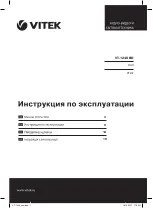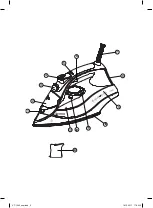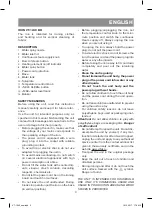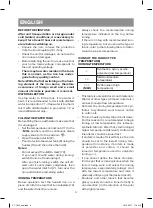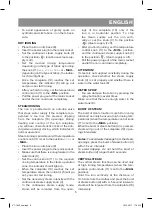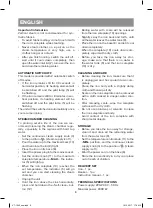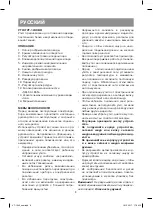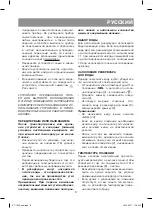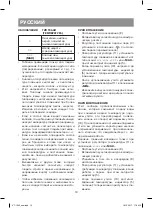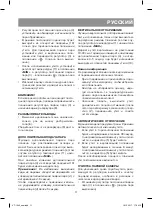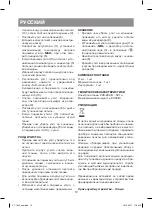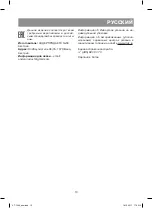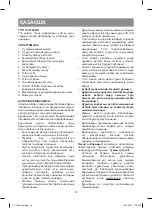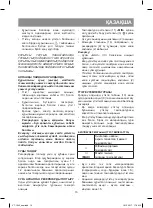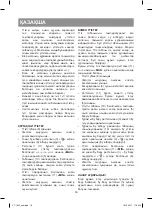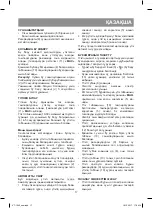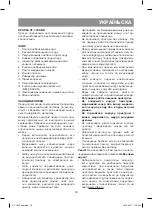
4
ENGLISH
BEFORE THE FIRST USE
After unit transportation or storage under
cold (winter) conditions, it is necessary to
keep it for at least 3 hours at room temper-
ature before switching on.
•
Unpack the iron; remove the protection
from the iron soleplate (10), if any.
•
Check the unit for damages; do not use the
iron in case of damages.
•
Before switching the unit on, make sure that
your home mains voltage corresponds to
the unit operating voltage.
•
There may be water residue in the tank,
this is normal, as the iron has under-
gone factory quality control.
Note: While the first switching on the heat-
ing element of the iron burns, therefore
occurrence of foreign smell and a small
amount of smoke is possible, it is normal.
WATER SELECTION
Use tap water to fill the tank. If tap water is
hard, it is recommended to mix it with distilled
water in proportion 1:1, if tap water is too hard,
mix it with distilled water in proportion 1:2 or
use distilled water only.
FILLING THE WATER TANK
Before filling the iron with water make sure that
it is unplugged.
•
Set the temperature control knob (11) to the
«
MIN
» position, and the continuous steam
supply knob (3) to the position «
».
•
Open the water inlet lid (2).
•
Pour water into the water tank (9) using the
beaker (14) and then close the lid (2).
Notes:
–
Do not exceed the «MAX» mark (13).
–
If you need to refill water during ironing,
switch the iron off and unplug it.
–
After you finish ironing, switch the unit off,
wait until it cools down completely, then
open the water inlet lid (2), turn over the
iron and drain the remaining water.
IRONING TEMPERATURE
Before operation test the heated iron on a
piece of cloth to be sure that iron soleplate (10)
and the water tank (9) are clean.
•
Always check the recommended ironing
temperature indicated on the tag before
ironing.
•
If there is no tag with recommended iron-
ing temperature, but you know the type of
fabric, refer to the following table to deter-
mine the proper temperature.
ICONS OF THE FABRIC TYPE
(TEMPERATURE)
IRONING TEMPERATURE
•
Synthetics, nylon, acrylic,
polyester (low temperature)
••
Silk/wool (medium
temperature)
•••
(МАХ)
Cotton/linen (high
temperature)
•
This table is only valid for smooth materials.
Fabrics of other types (crimped, raised etc.)
are best ironed at low temperature.
•
Sort items by ironing temperature first: syn-
thetics to synthetics, wool to wool, cotton
to cotton etc.
•
The iron heats up faster than it cools down.
For this reason it is recommended to begin
ironing at low temperature (for instance,
synthetic fabrics). After that, start ironing at
higher temperature (silk/wool). Cotton and
linen items should be ironed last.
•
If an item is made of mixed fabrics, the iron
should be set to the lowest ironing tem-
perature (for instance, if an item is made
of polyester and cotton, it should be
ironed at temperature used for polyester
ironing «
•
»).
•
If you cannot define the fabric structure,
find a spot that is inconspicuous when the
item is being worn and select the ironing
temperature experimentally (always start
with the lowest temperature and raise it
gradually until you get the desired result).
•
Corduroy and other fabrics that become
glossy quickly should be ironed strictly in
one direction (in the direction of the pile)
with slight pressure.
VT-1240_new.indd 4
19.12.2017 17:34:12
Summary of Contents for 138294
Page 1: ...1 VT 1240 BD 3 8 14 19 Iron VT 1240_new indd 1 19 12 2017 17 34 11...
Page 2: ...1 2 3 4 5 7 8 9 10 11 12 13 14 6 VT 1240_new indd 2 19 12 2017 17 34 12...
Page 10: ...10 8 3 11 MAX 5 10 5 11 MIN 10 11 MAX 8 9 11 5 10 5 VT 1240_new indd 10 19 12 2017 17 34 13...
Page 15: ...15 3 10 1 1 1 2 11 MIN 3 2 14 9 2 MAX 13 2 10 9 VT 1240_new indd 15 19 12 2017 17 34 13...
Page 20: ...20 3 10 1 1 1 2 11 MIN 3 2 14 9 2 MAX 13 2 10 9 VT 1240_new indd 20 19 12 2017 17 34 14...

